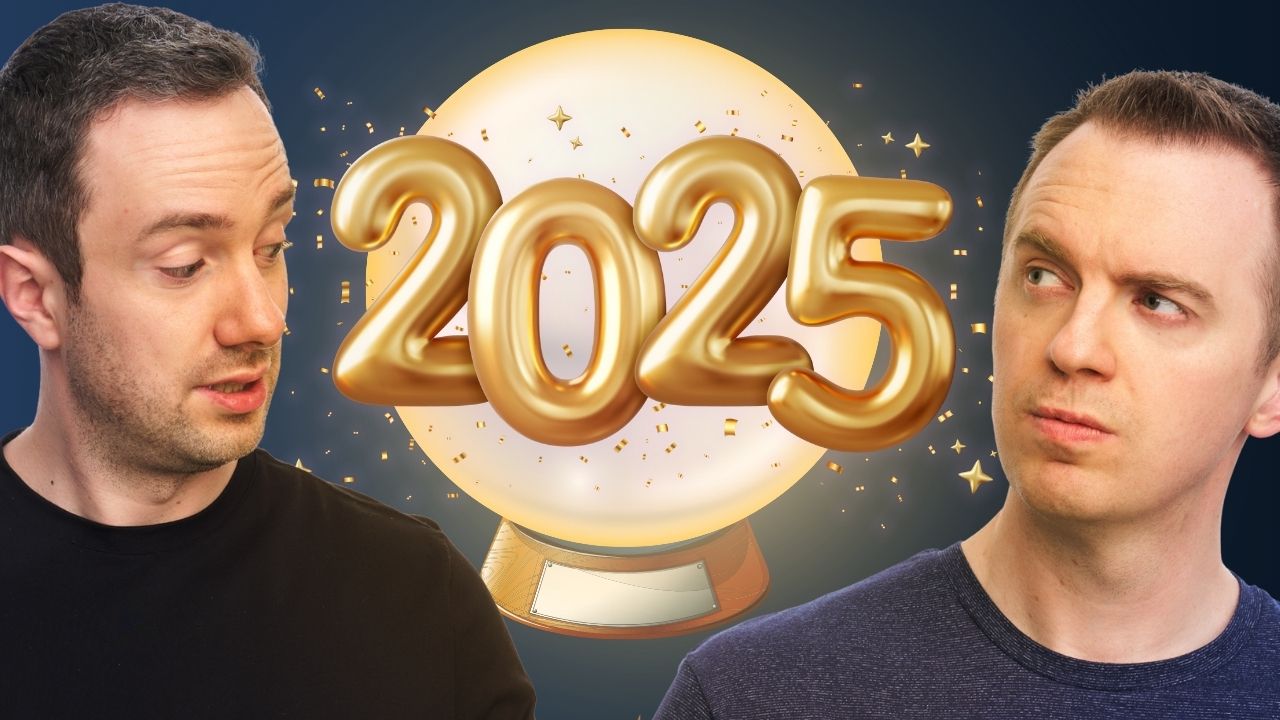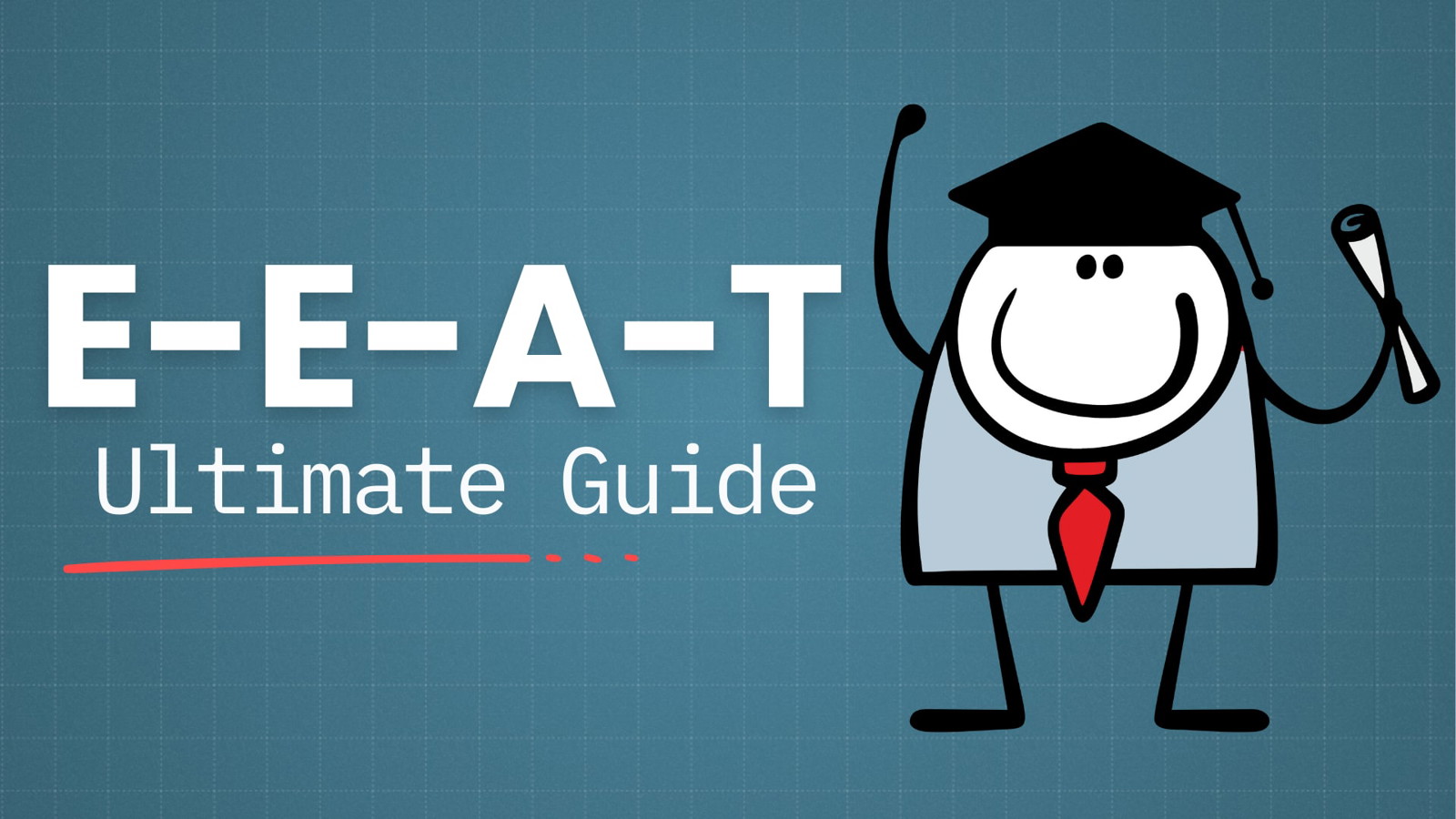I see a lot of advanced SEO’s shake their head as they see yet another blog post about title tags.
But hold onto your Twitter hate until you scrolled down a bit further on this page.
After all, Title tags are probably one of the best things to invest your time in as a search optimizer as they are clearly one of the most important factor when it comes to making your content relevant for your chosen keywords and they take less than 10 seconds to edit each.
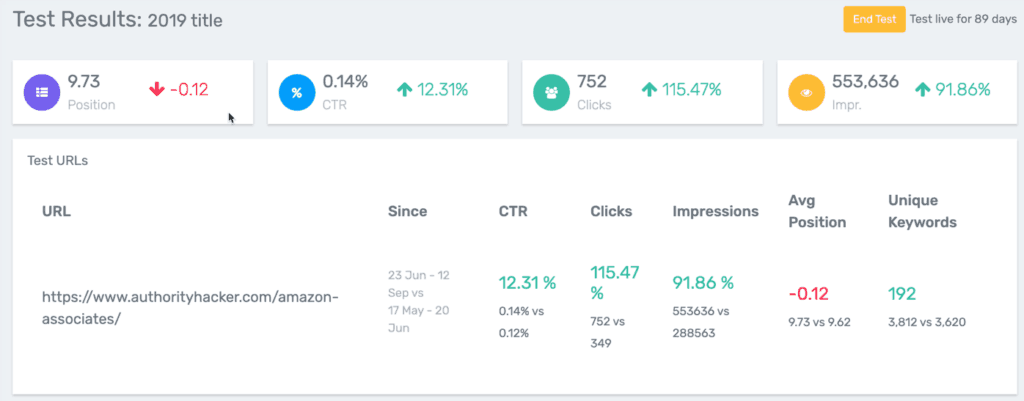
And as you can see from the title tag a/b test screenshot above, a well crafted title tag can easily increase your search traffic without increasing your rankings.
And this is why, learning how to craft highly clickable title tags can take your SEO game to the next level.
So in this post, we have looked at 1.5 million title tags to see what the most successful pages have in common and the results might surprise you.
But let’s put first things first for the most novice of our readers.
What Is a < title > Tag?
A < title > tag is an HTML element that determines the name of your web page.
It looks like this in the source code of your page:
< title >
How To Write The Best Headlines For Shares, Links & Traffic
< /title >
This piece of information is particularly valuable for browsers; they use it for tab titles, URL suggestions, bookmarks, and so on.
Here’s an example:
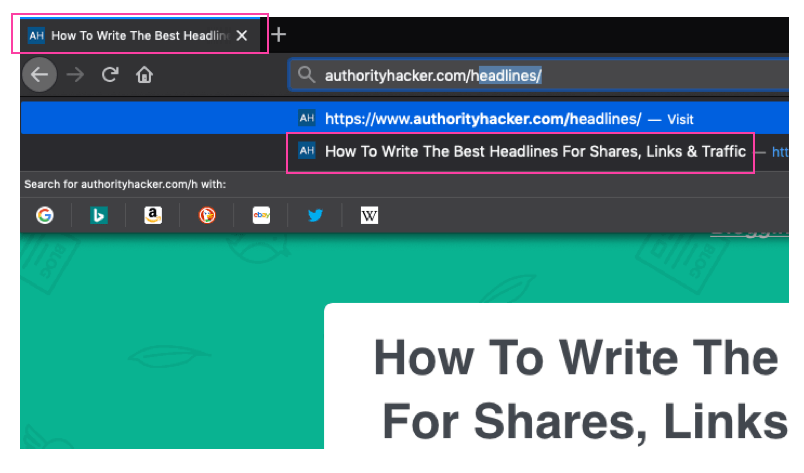
It is also used by search engines as the primary source of search result titles:

And the same goes for social media. Unless you customize your titles specifically for each particular platform (Facebook, Twitter), any link you share will display your < title > tag.
And so, quite often, it becomes your headline.
I say ‘quite often’, because Google can change your title if it is spammy, incomplete, or otherwise not sufficiently descriptive to be displayed in the search results.
To add more clarity, here’s what Google says:
If we’ve detected that a particular result has one of the above issues with its title, we may try to generate an improved title from anchors, on-page text, or other sources.
However, sometimes even pages with well-formulated, concise, descriptive titles will end up with different titles in our search results to better indicate their relevance to the query.
There’s a simple reason for this: the title tag as specified by a webmaster is limited to being static, fixed regardless of the query.
And here’s how Google’s Gary Illyes explains it:
We will never quit rewriting titles. We’ve seen so many sites whose titles really suck. A lot of sites have no title; a lot of sites have a title saying “Top Page”.
In fact, Google almost always rewrites titles. We couldn’t provide useful results to our users if we quit rewriting titles. Experiments showed us users preferred written titles. So, we’ll continue to write titles.
In other words, if you want to enjoy all the benefits of a solid SEO-worthy title that drives some traffic, you should stay within the guidelines, because bad titles get rewritten.
What A < Title > Tag Is NOT
A < title > tag is not your < h1 > tag.
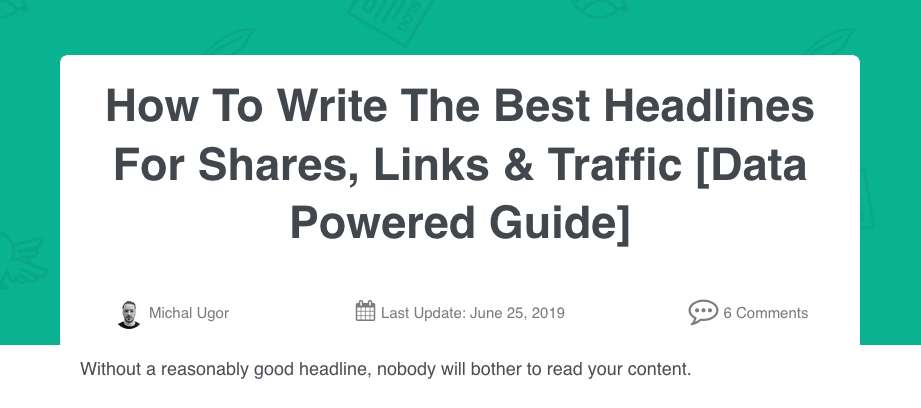
In HTML, < h > stands for the heading. So, whatever you use for the heading of your article on your page will only display to users once they land on your page.
That said, < h1 > tags, as well as the content, are very important for Google to rank your page.
It’s good practice to have your title very similar to your < h1 > headline.
That’s for two reasons:
- If people click on a title and see a different headline when they land on the page, it may confuse them and they may bounce.
- Google recognizes it. It tries to match your title with the
headline and the content. If the title is contradictory or doesn’t appear to be relevant it will downgrade your site.
A web page with a misleading title or a title that has nothing to do with the content on the page. Users who come to the page expecting content related to the title will feel tricked or deceived. (…) Any page or website that may deceive or trick users should be rated lowest, regardless of intent
In this document, Google provides many of these examples, as well as a solid walk-through of its criteria for downgrading content.
However, your H1 doesn’t have to exactly match your title tag.
You should take advantage of the fact that you are not limited in length like you are with your title tag to include more related keywords and make it more enticing to push your reader to consume the content.
Another important thing to mention is that < title > is not an < og: > tag.
stands for Facebook’s Open Graph, meaning you can add additional HTML markup to determine how your page shows up on Facebook.
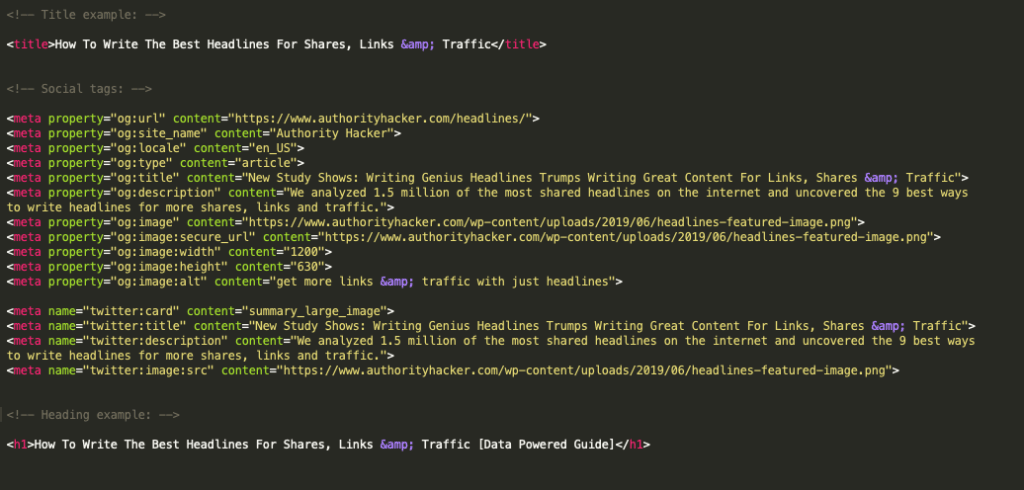
As you can see in the screenshot above, there’s also a tag to optimize for Twitter. If none of these are used, your < title > will be used.
That’s very useful because it allows you to be versatile with your headlines and optimize for SEO and social media at the same time. But more on that later.
Now, onto the study …
To sum this part up …
- < title > tag is the HTML title of your page.
- Its purpose is to be used by software like browsers or search engines
- Google looks at your tag as an important SEO signal
- It’s also what comes up in the search results
Therefore you want it to be optimized for both SEO and clicks - If Google thinks your title sucks, it will replace it and then you’re screwed
- Luckily, you can create separate titles for social media platforms
Our Study: We Looked at 1.5 Million < Title > Tags to Understand What Works Best in SEO
We took 15,000 long-tail keywords with a 1,000 – 12,000 searches a month and obtained the top 100 organic results for each.
We crawled each URL to get the < title > tag and < h > tags, and then we crawled a Google to get the actual Google title.
Finally we pulled some metrics like traffic, CPC, backlinks, etc. from Ahrefs.
Here’s a look at the < title > tags in database:

As you can see, Google is right in that there’s a heap of pages with useless titles, or no titles at all.
I wanted to point that out because it relates to one of our next points.
1 Google Does a Lot of Editing
As you can see in the chart below, a huge number of titles are either changed or truncated in Google search results.
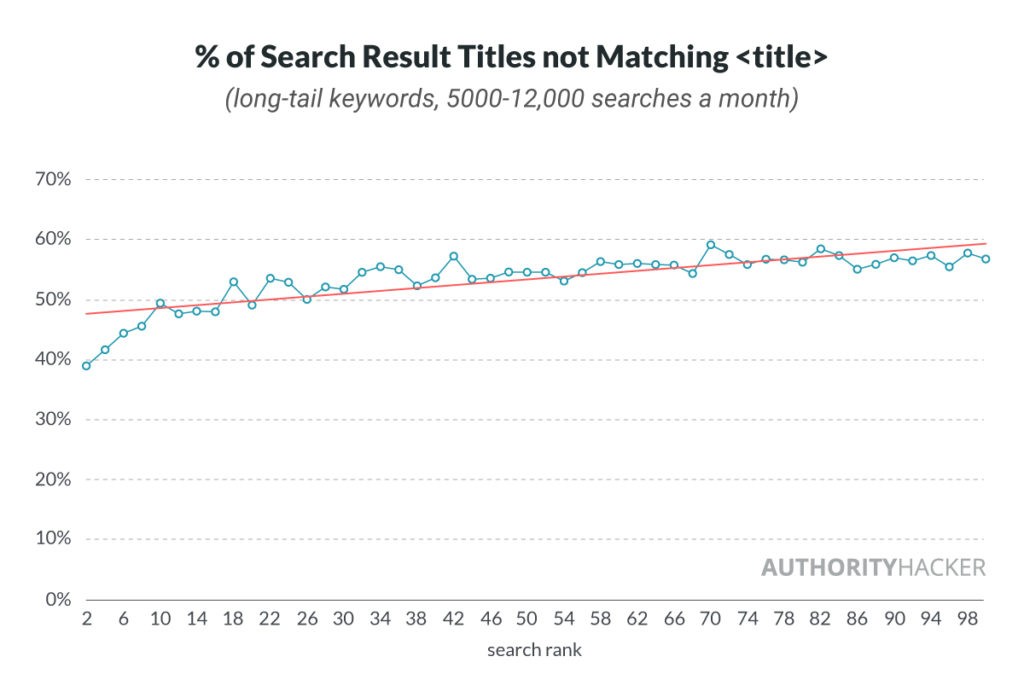
We compared lowercase strings and ignored small differences that can be assigned to encoding, like hyphens vs. dashes. Yet, we still ended up seeing some 50% figures.
This is understandable as there’s a great variety in how people write titles and, naturally, Google wants to show clean and user-friendly results.
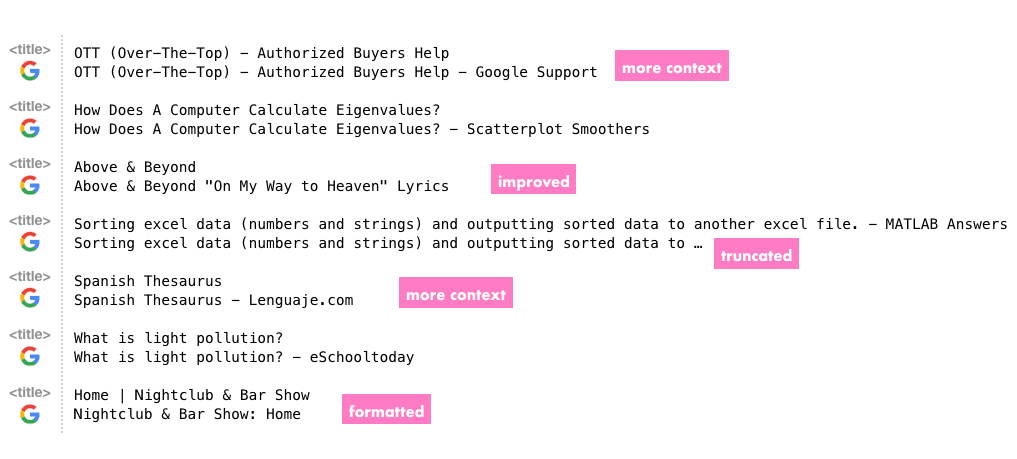
Likewise, most “rewriting” cases are simply Google providing more context or truncating titles that are too long.
A lot of that sort of editing is query dependent.
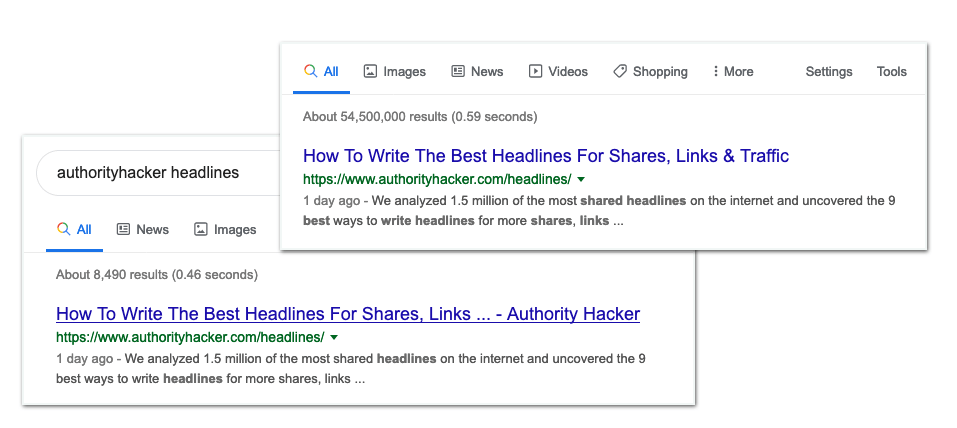
When I manually reviewed the original and edited titles, it mostly seems that Google uses a very simple algorithm.
Most changes fall in one of the following categories:
- Google adds a source e.g. title – The Economist.
- Google truncates the long title.
- In the case of no title, it uses the <h> tag, i.e. the actual headline.
- Reorders the title/brand, e.g. Biznews :: title –> title – Biznews or Biznews: title

Interestingly, we found no correlation between Google editing or reordering the title and the search rank. It doesn’t seem to be a negative signal. Editing is simply something Google does.
Most of the correlation in the chart above actually comes from truncated titles.
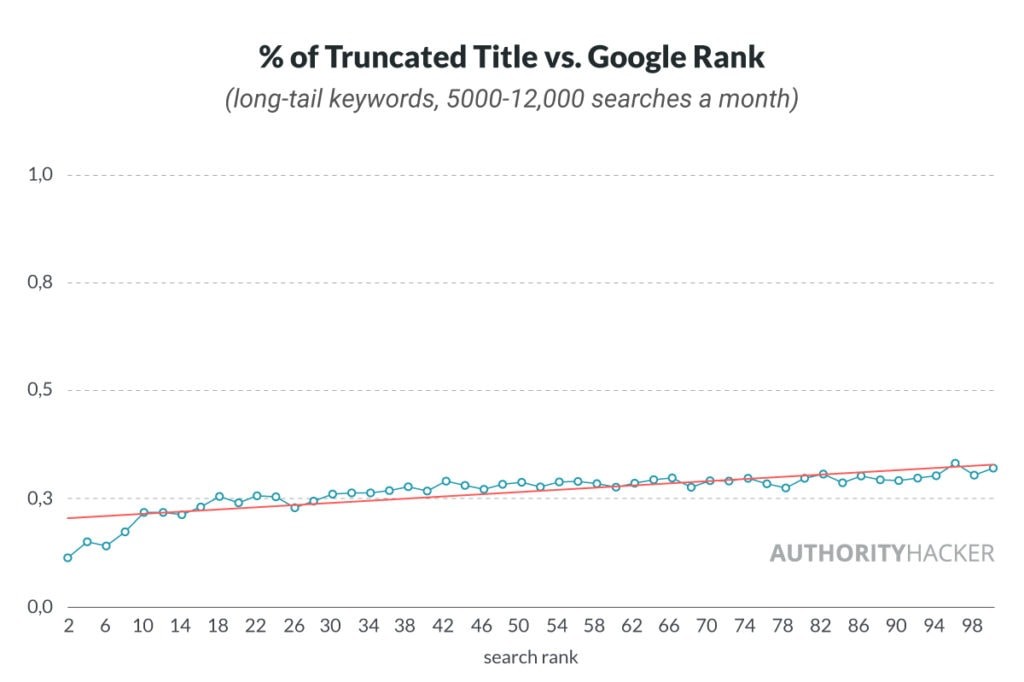
It seems that, in the higher ranks, there are fewer titles that need to be truncated overall. We can only speculate why, as correlations don’t represent the cause.
The length may not be the signal itself, but rather the presence of spammy titles with many keywords or poorly formatted garbage titles, like this one here:
24 Calories: Cantaloupe – Low Calorie Foods: 50 Low Calorie Foods That Pack Flavor – Shape Magazine | Healthy & Low Cal Foods | Cantaloupe salad, Cantaloupe cu…
I would assume that, for example, not having the title at all would also be a negative signal as it indicates a poor quality page, but we found no correlation here either.

In these cases, Google simply uses the < h > tag that serves as the headline for its title.
The only link we found was that pages with no < title > tag get way less organic traffic. We found this to be the case with truncated titles too.
Apparently, if you add pages without clear < h > tags into the mix, Google will have a hard time determining the headline and computer-generated headlines get fewer clicks.
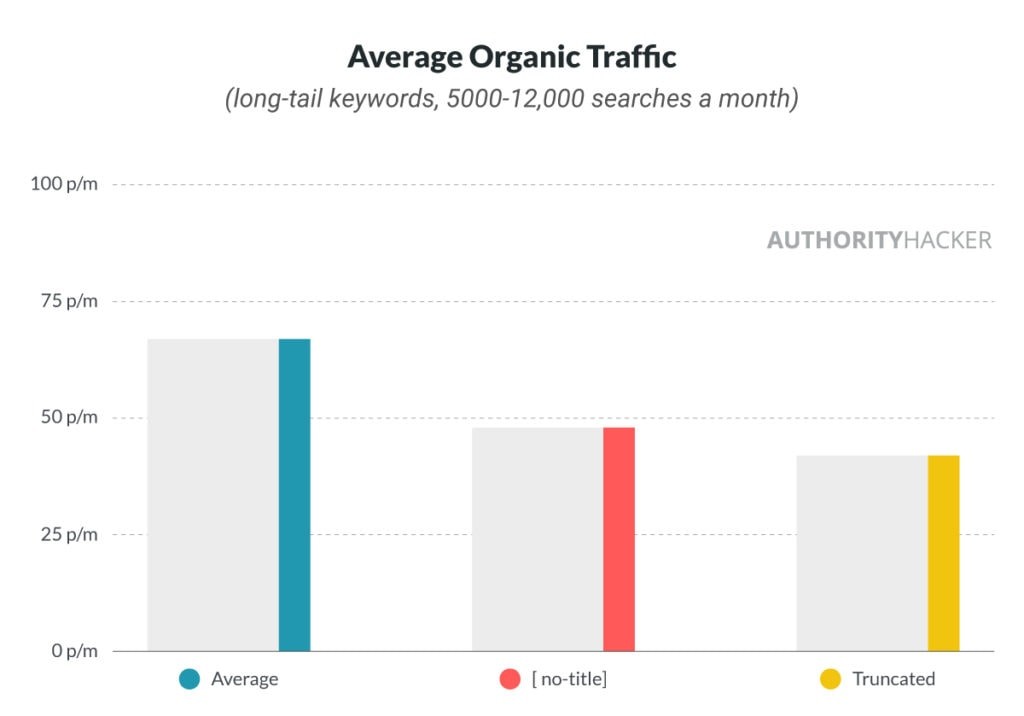
Conclusion
A lot of information presented here is more interesting than useful. But, if you’re going to write titles it may come in handy to know how it shows up in the search results.
Obviously, titles are what people read and click on. A truncated title won’t deliver the full context and the data confirms that they get way less organic traffic (clicks) than the average.
Finally, the idea that Google rewrites titles is overrated. Most titles aren’t really rewritten, including some nonsensical titles, but rather improved in the most primitive algorithmic way.
That is the addition of a brand, cleaning up duplicate parts, reordering, or truncating.
2 What’s the Optimal Length?
OK, so one thing is clear — you don’t want your title truncated.
The Google search results title is kind of like the subject line of an email. Shitty subject lines don’t get opened and it’s the same with poorly written titles.
Even if your title is written by the reincarnated David Ogilvy himself, if it’s too long for Google to display in the search results nobody will get to read it.
There is no specified character range but Google allows the length to be 600px. That’s about 80 characters, depending on your choice of characters, as some take up more space.

In our dataset, the longest Google search results title is 82 characters long. The longest untruncated title is 78 characters long.
Bear in mind that Google may extend it by adding your brand, meaning it will cut out a part of the readable text. So, I recommend that you concentrate the most meaningful part of the title within the first 50 characters or so.
This seems to be a rather new thing as Google recently changed the fonts they use on title tags for Desktop results which made them drop a few characters.
So basically, you can write titles up to around 80 characters but many times, only the first 50 will be used and you will end up with a truncated title. So if you want to optimize things, a 50 character title tag seems to be the way to go in 2025.
And the data seems to be confirming this assumption as clearly, the pages that follow this rule seem to be ranking higher on average as the graph below will show you:
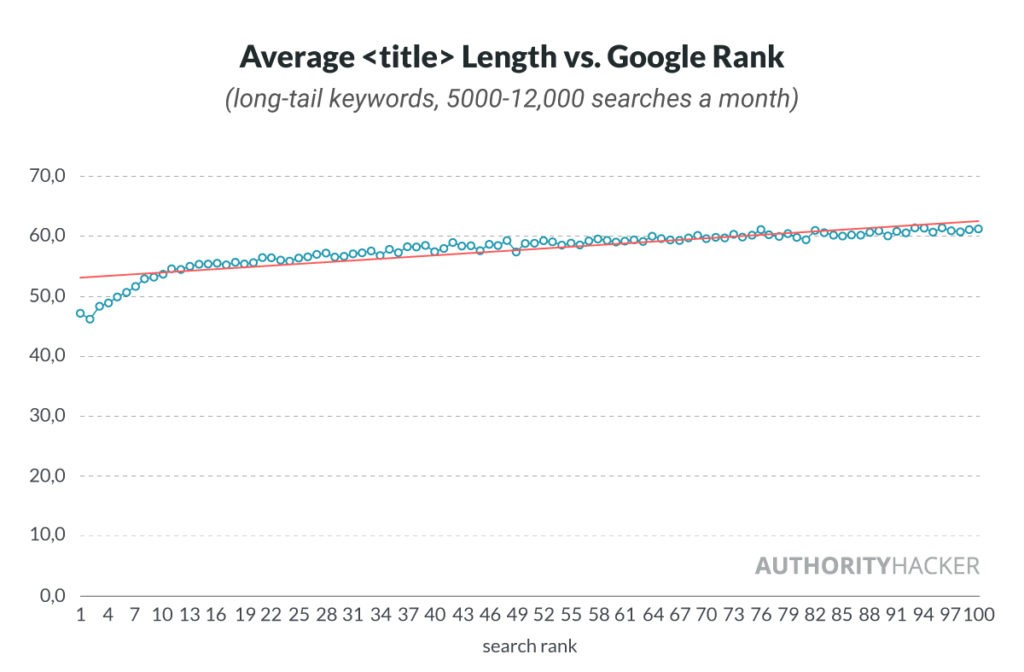
The median values were pretty much identical to averages, even after we kicked out all the homepage results and focused on inner pages only.
I’ve seen this repeatedly in previous studies; strong correlations for shorter URLs, headlines, anchor texts, and so on.
I think that one way to interpret it is that there are more spammy, keyword-stuffed titles in the lower ranks. It’s also highly likely that Google prefers straightforward titles.
In fact, it explicitly states so:

Organic traffic correlates positively with shorter titles too. That’s understandable as people are lazy, so when they do a search they look for the most direct answer.
It’s just more user-friendly for Google to display shorter titles.
But here’s the tricky part – LONGER headlines correlate with more social shares as found in our headlines study.
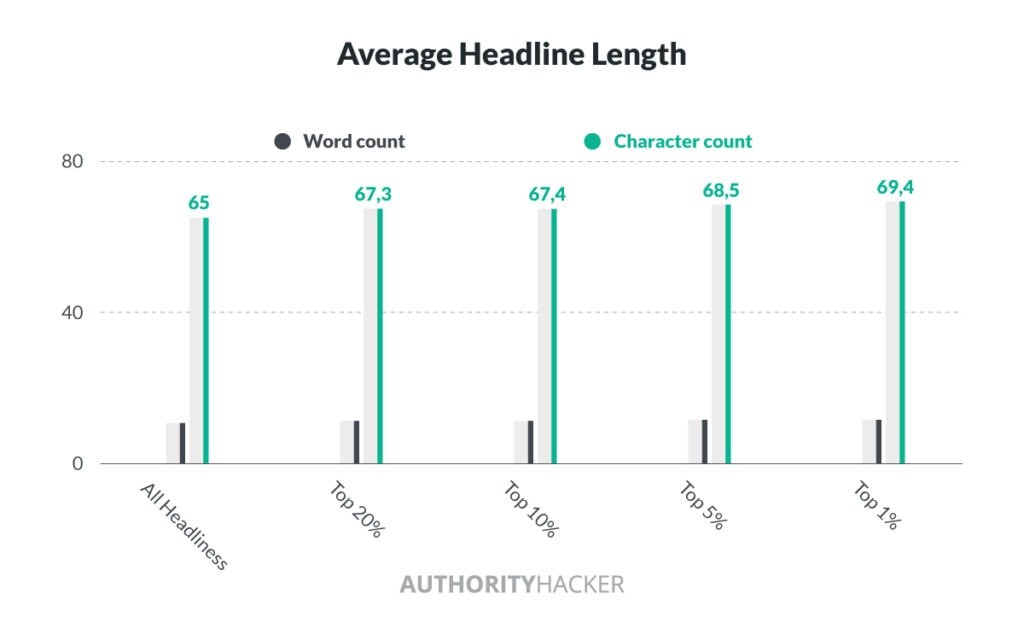
So, you’ll want to use OG tags and Twitter cards to your full advantage.
Conclusion
This one is clear. You want your title length to be on-point and relevant. It should be in the 50 character range to be optimized both for Google’s rewriting rules and their new font sizes.
It’s funny because now that Google essentially uses some of your “title tag length credit” to append your brand at the end, shorter brands get more title tag length than longer ones. Damn you Moz!
3 Keyword Match
In our previous study on ranking factors, we found a relatively solid correlation between Google rank and keywords in the title.
This time, we did it a bit differently.
We used the SequenceMatcher method from Python’s difflib module–a similarity-matching algorithm, built around the standard CS theory for comparing sequences.
So, this gives us something that’s closer to what Google is likely using to match similar keywords with each other.
Here’s the result:
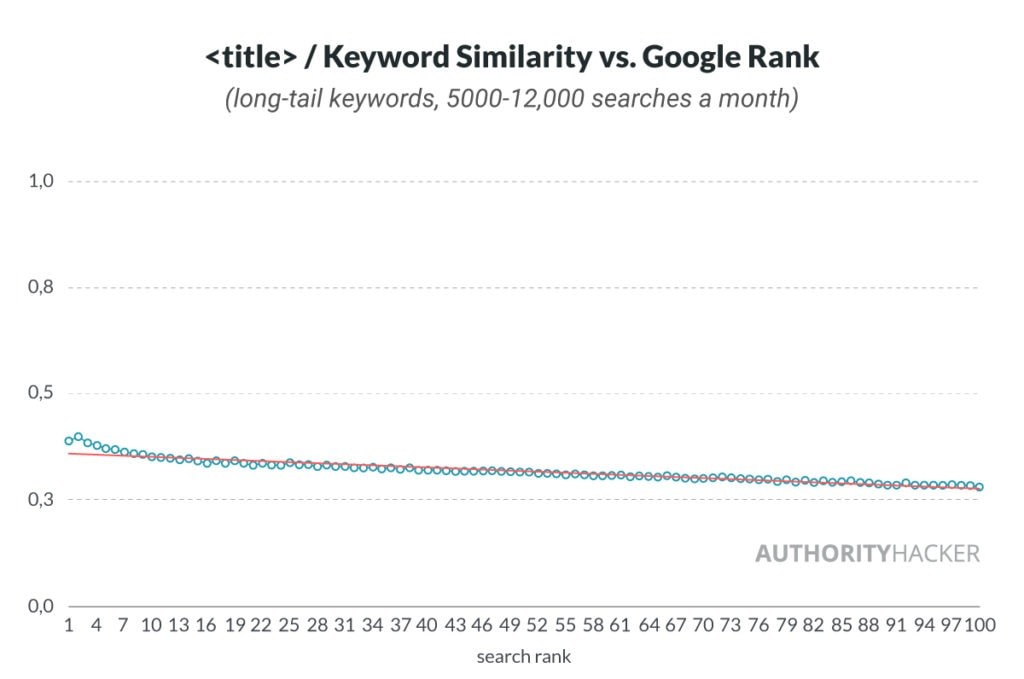
This result is a much stronger result than what we got by simply matching the keyword with the content in the < title > tag.
This shows that this method probably is closer to what Google is doing and confirms that they are quite good at understanding synonyms and relevance.
This is especially true if a keyword has multiple variations, I would not get out of my way to try to include them all in the title, Google is very likely to figure it out if your main keyword is here.
Conclusion
With long-tail keywords, we found it harder to correlate the exact match in the title. Yet, similarity shows a clear conclusion.
That means that, with short tail keywords, it’s easier to place the exact keyword inside the title, but with longer tail keywords, I wouldn’t bother to exactly match the keyword exactly if it’s not natural. Rather, find the closest natural language title that also feels good from a readability perspective while respecting the max title length.
Remember, computers are not as smart as humans so keep things simple and write your titles relevant to the keyword, in a manner that a 5th grader would find easy to read.
4 Title and Headline Similarity
The next thing we looked at was the similarity between the < title > tag and the main tag of the readable part of the content, aka the main content (MC).
But, before we get to those results, I would like to show you this chart of the similarity between the H1 and the query keyword.
The results are very similar:
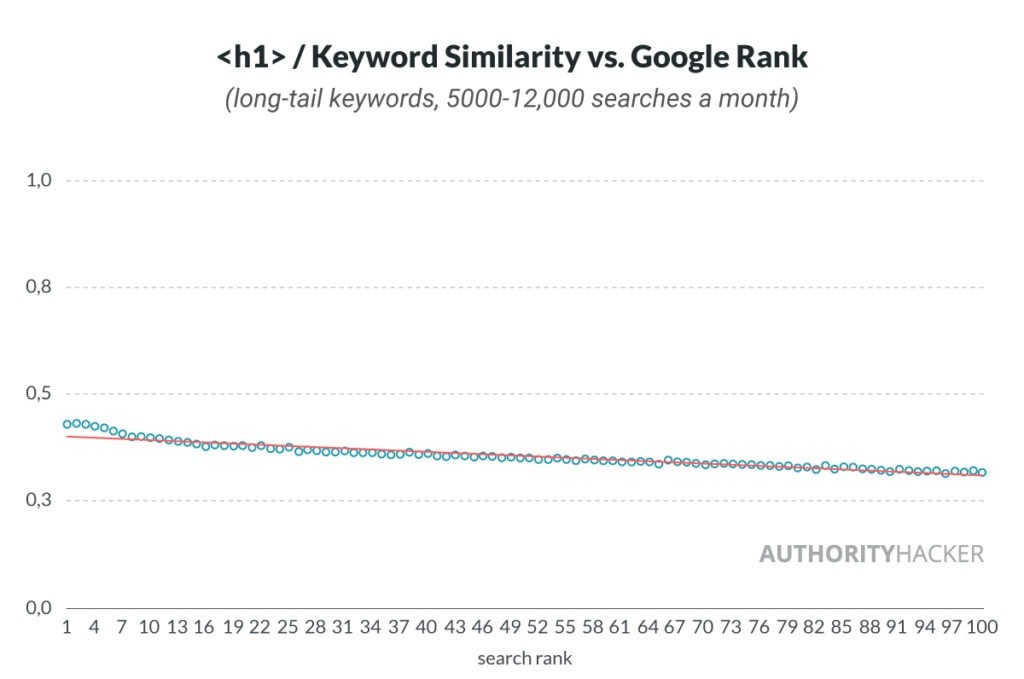
In its Search Quality Guidelines document, Google explains how it rates “low-quality pages”. Among other categories, “deceptive pages” are considered low quality.
Such a web page is defined as:
A web page with a misleading title or a title that has nothing to do with the content on the page. Users who come to the page expecting content related to the title will feel tricked or deceived.
Any page or website that may deceive or trick users should be rated lowest, regardless of intent.”
That’s a spot-on explanation for why you don’t want your title to deviate from the main content’s headline too much.
Here’s an example from the document:
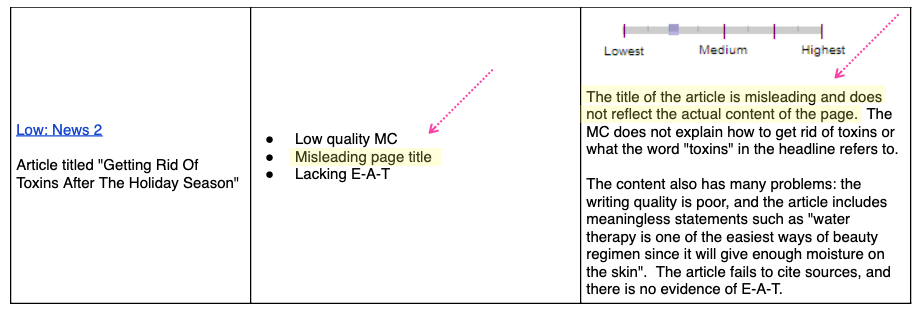
And here’s another one:
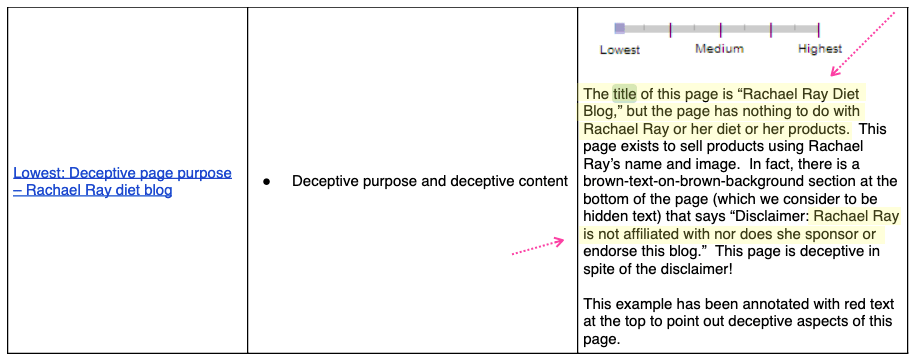
Here’s the interesting thing. Both the < title > tag and the main < h > tag correlate well with the keyword.
But, when we compared the similarity of the < title > and the main < h > tag, here’s what we got:
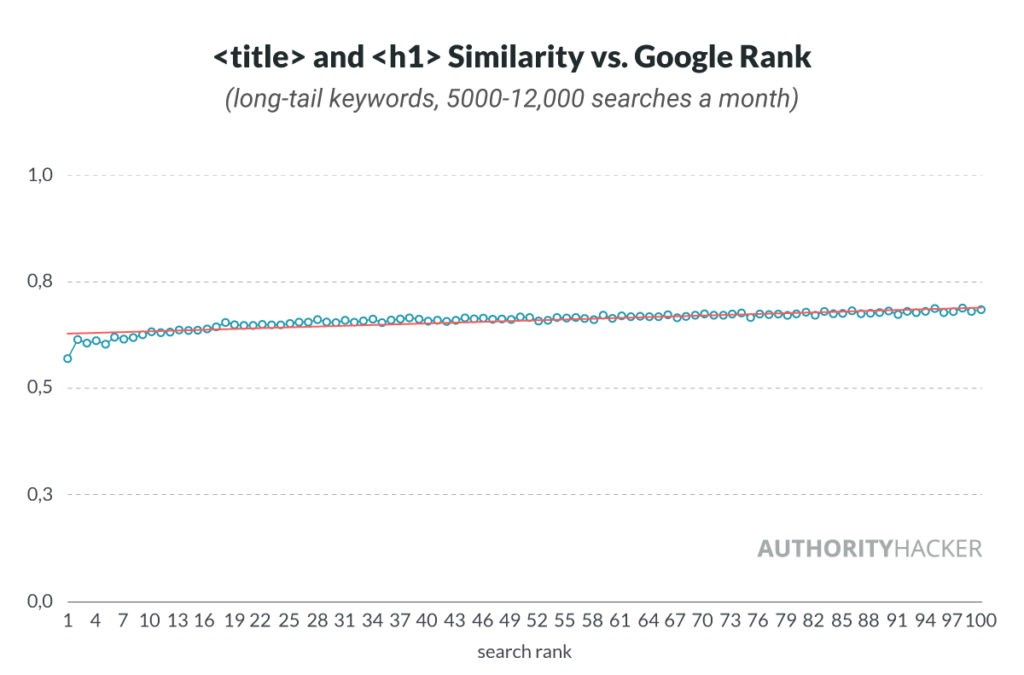
Note that in < h > and < title > similarity tests, all ranks scored mostly above 0.6, which means the sequences are close matches. But the correlation is negative.
Let’s sum it up again:
- Higher ranks have their < title > more similar to the keyword than the lower ranks.
- Higher ranks have their main < h > tag more similar to the keyword than the lower ranks.
- Higher ranks have their < title > and main < h > very similar, but less so than the lower ranks.
This means that top publishers do understand that they need to keep their title tags extremely short but don’t have to follow that rule for their H1 tags.
So they write an H1 that’s heavily inspired by the copy of their title tags but takes advantage of the extra allowed length to inject more related keywords and keyword modifiers while turning also polishing the copywriting to make it more exciting and shareable.
Here is the same analysis but looking at the H1 exactly matching the title tag. As you can see, the trend is even clearer.

Conclusion
You want your title and your main headline to be relevant to the topic you want it to rank for. That means that both should contain a variation of the keyword.
When it comes to the relation between the title and the main content, Google makes it clear: “The title of the page should describe the content,” citing from the Search Quality doc.
Make sure your title and the headline objectively describe the content. Make sure they are similar too, so when the user opens the page they will find what they were looking for.
Based on the high similarity scores, you should keep your < title > very similar to your < h1 > headline. However, having them completely identical seems to be a negative signal.
5 Copywriting the Title
A couple more things that I picked up from Google’s Search Quality doc– there are also guidelines on rating pages with “shocking or exaggerated” titles as low quality.
Here’s another snippet:
Pages with exaggerated or shocking titles that do not describe the MC well should be rated Low. (…) Exaggerated or shocking titles can entice users to click on pages in search results. If pages do not live up to the exaggerated or shocking title or images, the experience leaves users feeling surprised and confused.
And here’s a couple of examples:
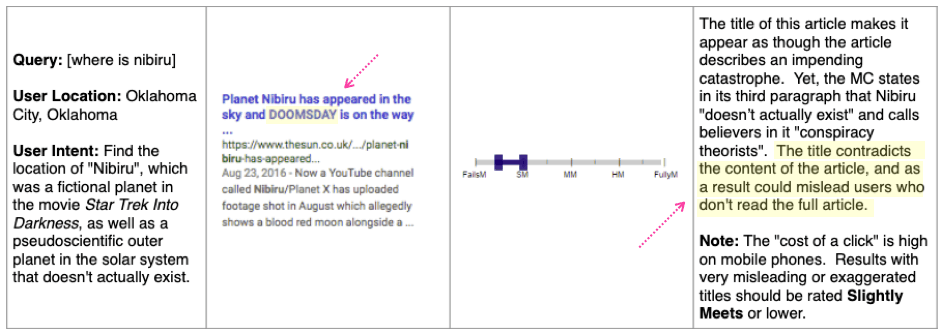

In our headlines study, we found that the use of some “power words” correlate with higher (or lower) social shares too.
As you can see, the choice of words can affect your SEO too, although in a different way than with getting social clicks and shares.
This is benchmarked against the content and it is hard to measure.
Apparently, even Google’s own algorithm doesn’t do a perfect job if they need to hire human raters to manually evaluate the results.
We simply can’t reliably look for relations between rankings and the words used in the title–1.5 million is too small a dataset to find anything meaningful.
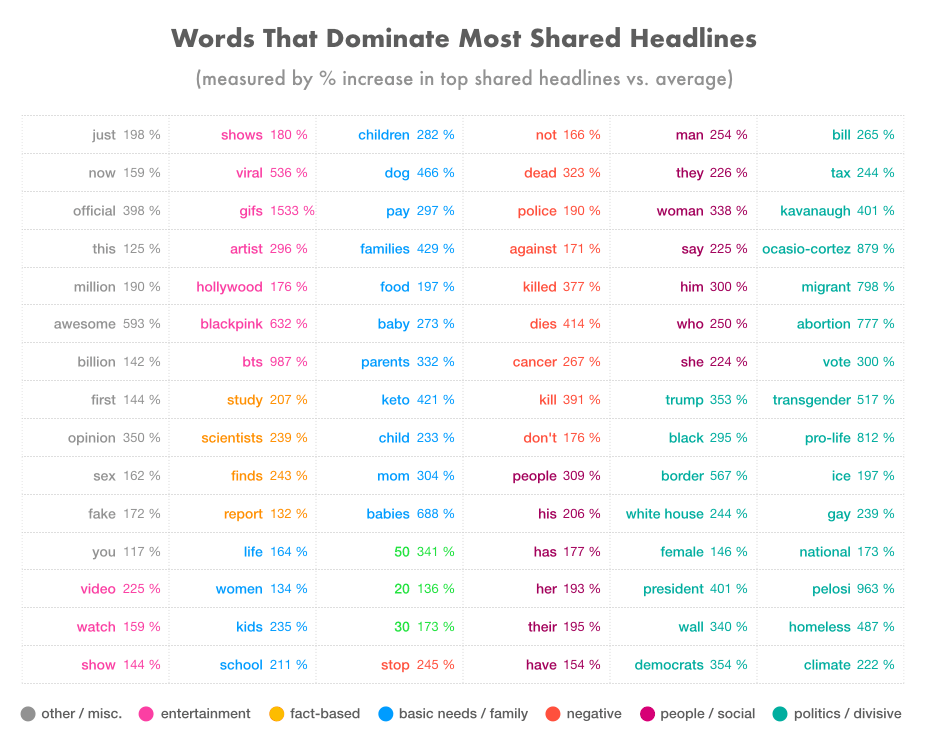
We could look at organic traffic, and we did … but again there are more factors that play a role and we already did a huge study on headlines which gives reliable results.
As what I got from this analysis isn’t too far from what we found in our headlines study, I will just point you there as it’s much more elaborate in terms of copywriting advice.
Conclusion
Even if you rank in the top 10, you want users to click on your result. And most of the time, they’ll only read the title, making it the deciding factor.
The same copywriting advice applies here, although it’s a little more nuanced when it comes to SEO.
If you’re going to use some aggressive headlines, make sure your content delivers. If you struggle to move up in ranks, try to tone the title down a bit, especially if the CPC is high.
Consider the keyword and put yourself in the position of the user too. Ask yourself: “What do they expect to get from the query and what would be the best way to make your headline reflect that?”
6 Title Topics and SEO
As I stated before, we can’t do a correlation study on title topics affecting SEO, for the reasons explained. Nevertheless, there were a few that stood out or are an obvious choice.
As you can see, Google marks the titles with words like “shocking” that imply exaggeration. I had a look at our headlines study and came up with a few ideas.
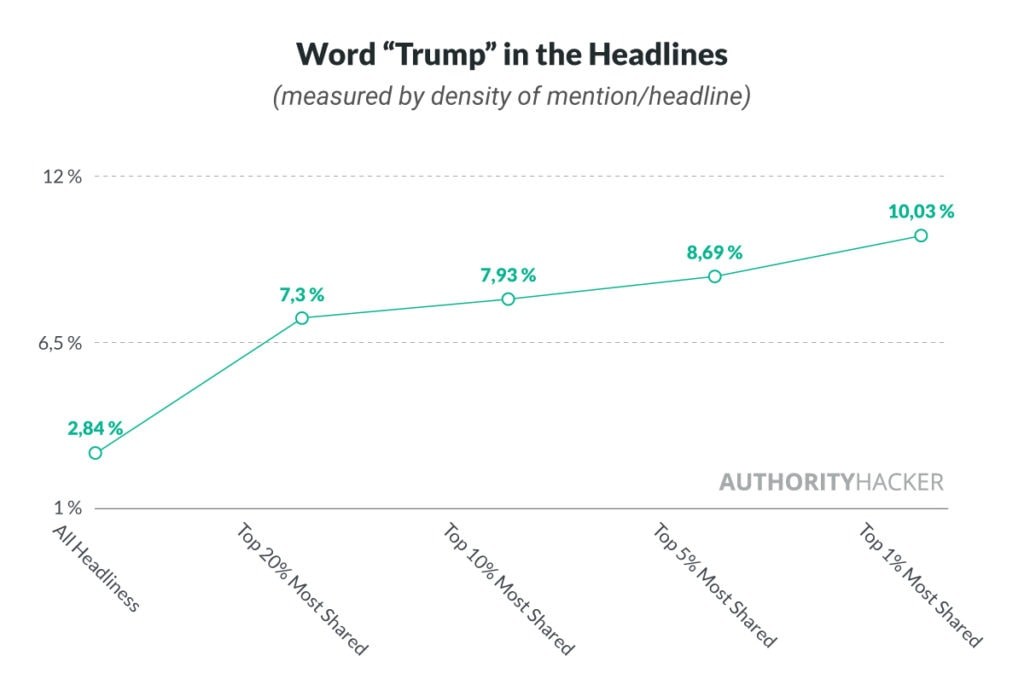
We found the word “trump” to be highly correlated socially with clicks and sharing. Is it the case with SEO?
Here’s what we got:
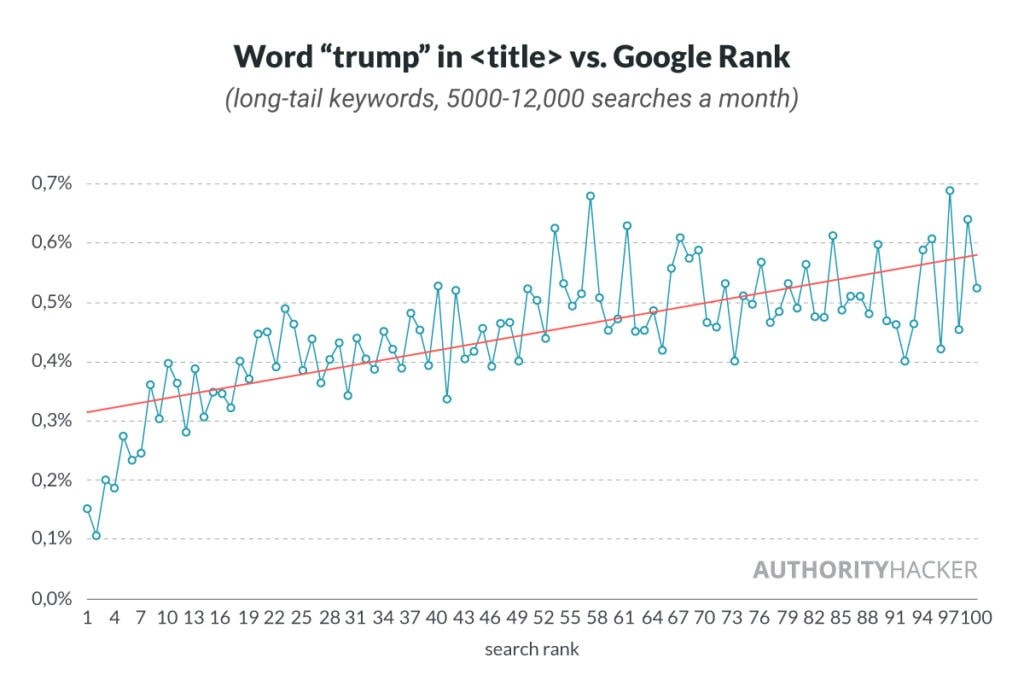
The word “trump” is consistently less present among the higher ranks. For whatever reason.
This is interesting because the same factors that increase your chances to make your content viral may actually hurt your SEO, especially if you go too far.
Next, we looked at the “freshness factor”, something I found to be often talked about by SEOs.
Here’s how stating the current year in your title tag correlates with search ranks:
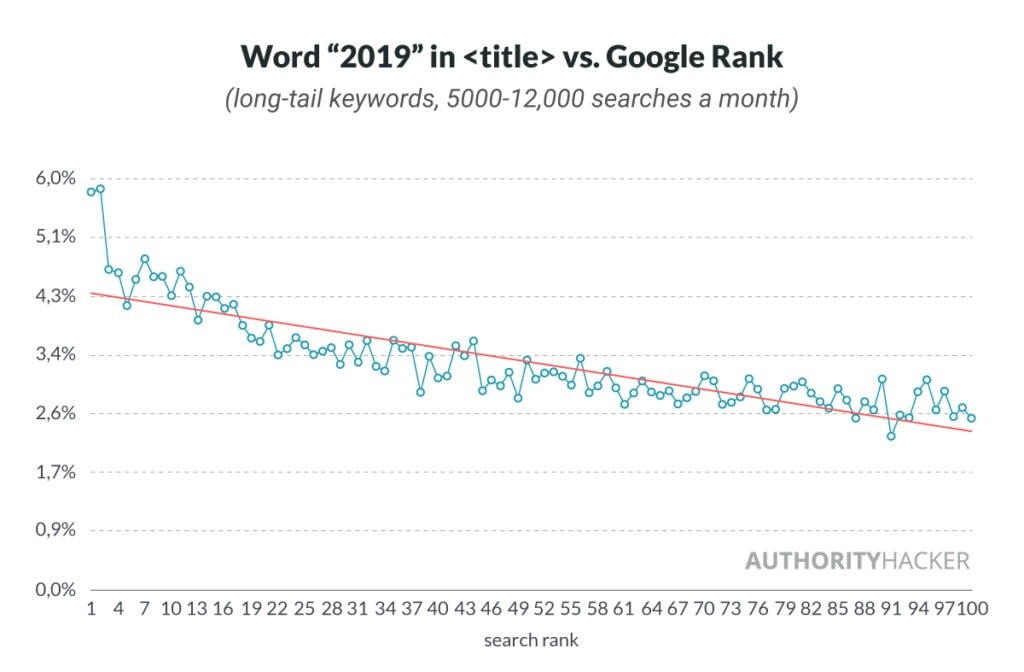
Clearly, having the current year in title does correlate with high rankings.
Is it because users like it and click it more which sends a positive signal to Google or is it just Google associating your content with more recent dates? Hard to tell but in the end, when you can, have the current year in your title tag.
We then looked at a bunch of other stuff, like the use of an exclamation mark or capitalized letters, things typically used in clickbaits, the use of numbers and list posts, etc. without conclusive results.
Conclusion
I think the word “2019” or the “freshness factor” shows the strongest link. It might also be that the content actually is fresh and therefore more likely to contain such a keyword.
In either case, if you have an objective reason to use power words in your headlines, do so, because they also positively correlate with social shares and clicks.
For the results of the word “trump”, it could be that the media likes to use shocking and exaggerated “Trump” headlines because it works, but fails to deliver the content.
Nevertheless, I would make a case for being careful in using polarizing topics in your title just to drive clicks and use them for social media ( tags) only.
How To Write Title Tags That Get You Rankings and Clicks
I would like to say that < title > tags are one of those 0,1% wins in SEO, but they’re more important than that because their content is what makes people click on the result.
It pays off to take this seriously.
So let’s write the title tag for this very blog post together so I can show you how we do things here at Authority Hacker.
1. Insert your main keyword
The first thing we do when we write our title tags here at Authority Hacker is write our main keyword in the title tag field just to get an idea of how many characters are eaten up by it already Many times for long tail keywords, this will be most of your title tag.

2. Plug the Keyword in Ahref’s Keyword Explorer and Look For Interesting Modifiers to Add
The next step is to plug your main keyword in your favorite keyword research tool and look for relevant long-tail variations with search volume.
In the case of this post, I highlighted 4 that are potentially interesting below:
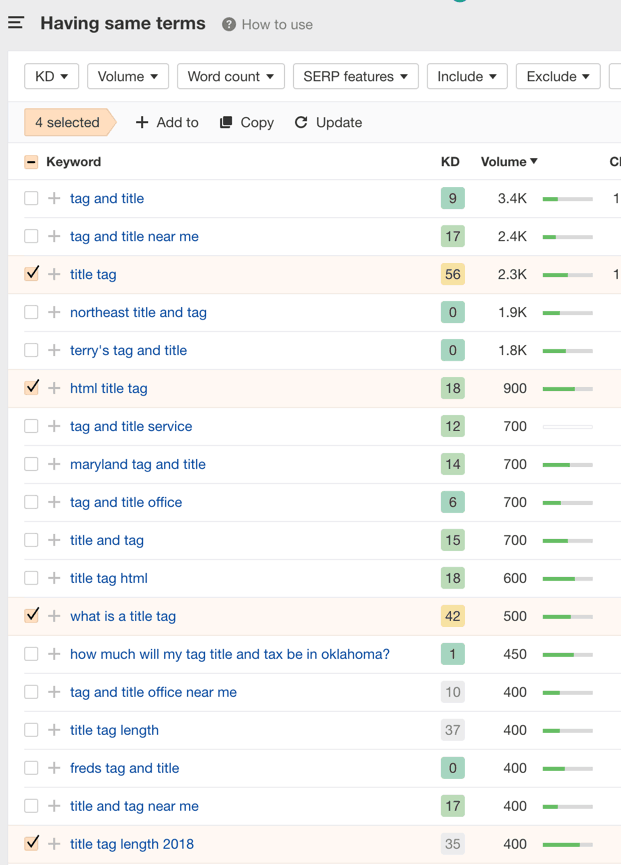
Obviously, you want to check the competition of the long tail variations to see if you have a shot at ranking for them and analyze them as if you were doing seed keyword research.
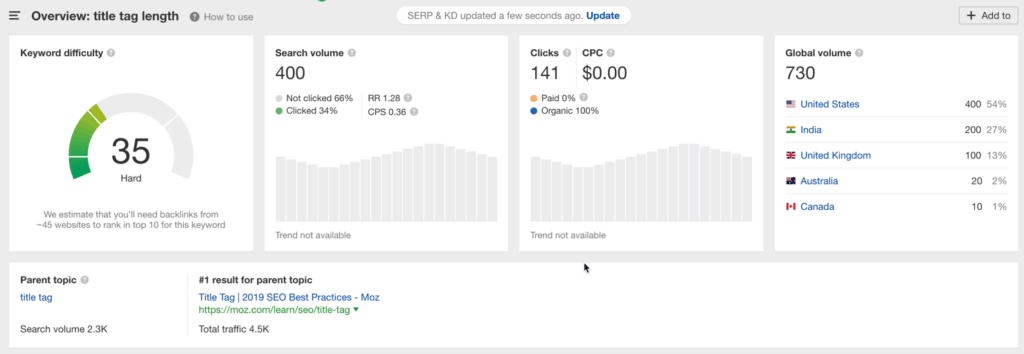
Pick the best modifiers that make sense with your actual content (otherwise, you won’t rank anyway), and throw them in your title tag box to get an idea of how many characters you need. Remember, the most important part of your title should be within the first 50 characters because Google WILL truncate it sometimes.
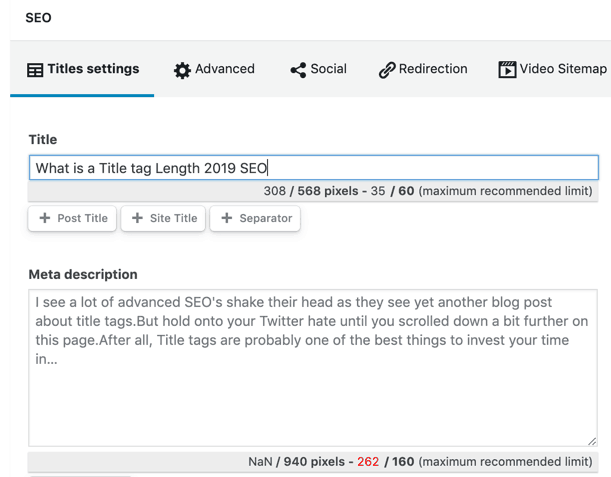
3. Write a Title Tag That’s Readable, Describes Your Content and Makes Sense Using Most of the Modifiers You Can Fit In
This part can be tricky. Fitting all your modifiers and main keywords while making sense within 50 characters means that sometimes, you will need to make sacrifices so take a final look at your keywords in the keyword explorer if you have to make hard decisions.
Here is what I landed with for this post:

Don’t forget to capitalize words with 3 or more characters to attract more attention in the SERP’s.
I then made the year dynamic in my tag using the %%currentyear%% tag most SEO plugins offer and that’s my final copy:

Don’t worry, the title tag will be 50 characters in the end, it’s just that the tag is quite long which messes with the character counter.
4. Write Your Social Tags for Shareability and Click Through Rate
Social headlines follow different success factors so you don’t want your Google title and your social media headlines fighting with each other.
As we’ve shown, longer headlines perform better on social media but shorter ones do better on Google. Google titles require a keyword, social media headlines don’t. And so on…
One of the angles that have been shown to correlate with higher shares and traffic is the “New Study” angle, so I decided to use it for this article as we actually ran a study over 1.5 million title tags.

It’s also 68 characters which is exactly in line with what’s been proven to get more results as per our headlines article. We also show you how to use paid ads to optimize your social headlines at the end of that post so I recommend you check it out ;).
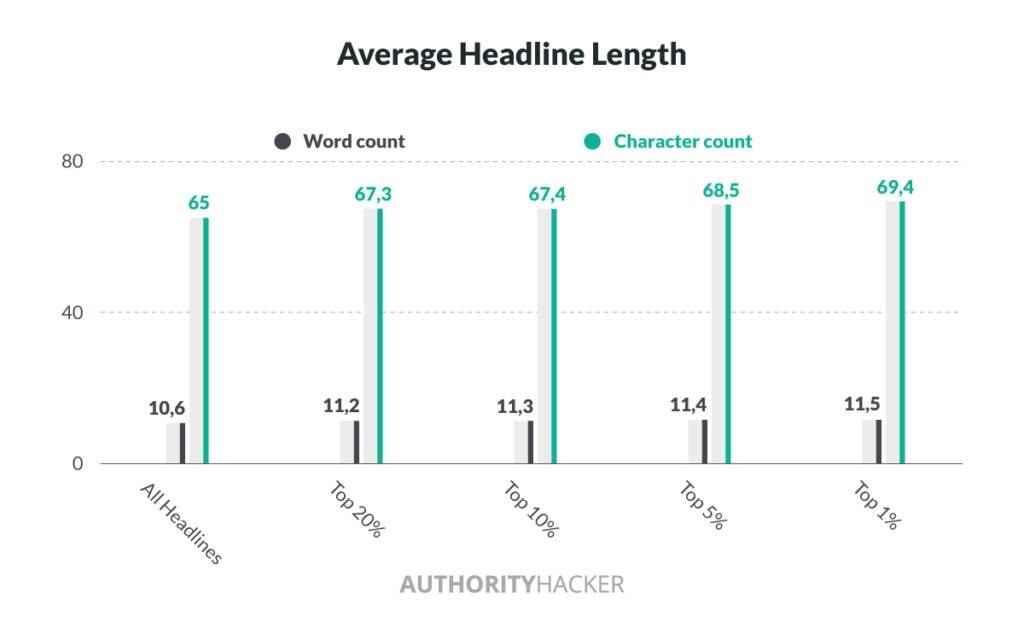
5. Write an H1 Tag That Reconciles Your SEO Title Tag and Social Media Headlines
The last thing you want is to be classified as deceptive by Google and clickbait by your social traffic.
So now, our job is to write an H1 that bridges the gap between our keyword rich title tag and click-worthy social headline so everyone feels like they landed in the right place and is excited to consume your content.
Also note that the occurrence of keywords and modifiers is important in your H1, so you need to make it both keyword rich and enticing. But in exchange, you are not limited in length.

I guess if you are still reading, we’ve achieved that so I don’t need to do it. But.. If I don’t do it, I guess you won’t read this far.
But I guess you’ve seen the headline already… anyway, here is what I came up with:

6. A/B Testing Your Title Tags to Maximize Your Results
A/B testing title tags is something that used to be only available to massive sites with huge budgets. But not anymore. We gave a shot to abrankings.com and they are surprisingly reliable.
Obviously, title tag testing is NOT easy and always reliable because your rankings will move all the time, regardless of what you do.
So “winning” tests, are not always due to your title variation, but also to the fluctuations of how prominently Google pushes your content.

We recommend that you cycle the modifiers that you found in ahrefs in your copy to see which ones bring the most overall traffic and best click-through rate.
We might do a tutorial on this soon but this post is getting a bit long already :).
To Wrap Up…
In SEO, you want to view each piece of content as a distinct product release.
A product requires market research, a budget, a clear objective and performance goals, and it also needs a distribution strategy.
Writing a solid title is a part of building and releasing a working product that is your content.
Therefore, you want to treat it as such.
What I mean is that title tags are an important detail and writing them should be a piece of cake as long as you know what you’re trying to achieve and who your article is intended for.
If you’ve done your research, you know what keyword you’re targeting, who your competition is, what your assets are (i.e. your article’s UVP), what pain your readers are trying to solve and what gets in their head.
A solid title will reflect all of that.



